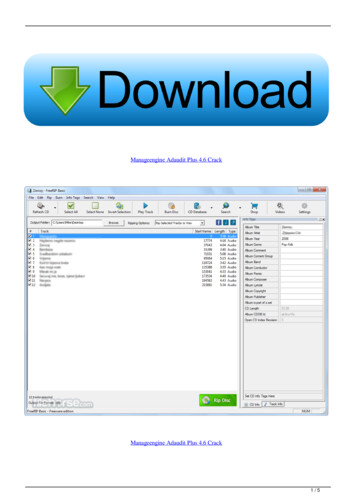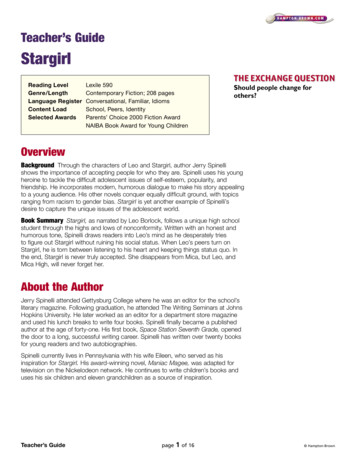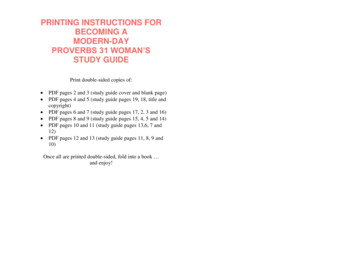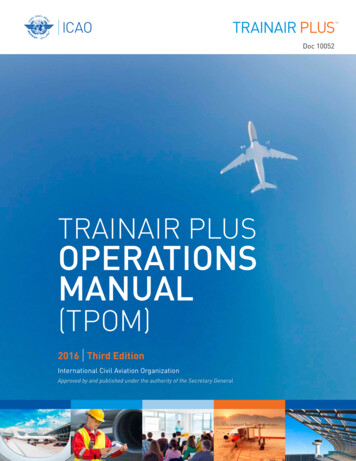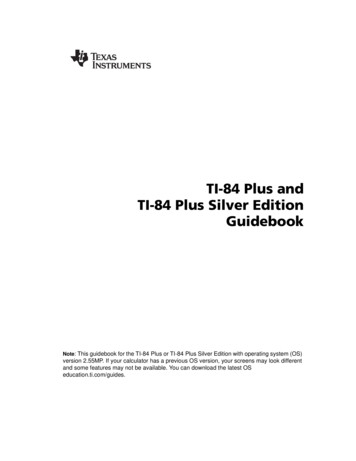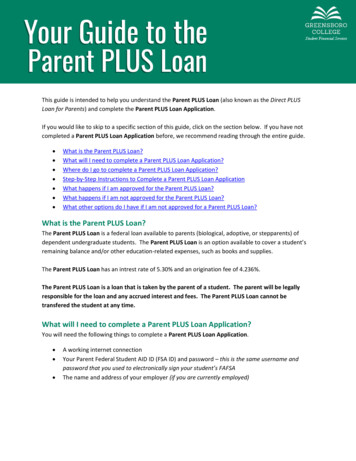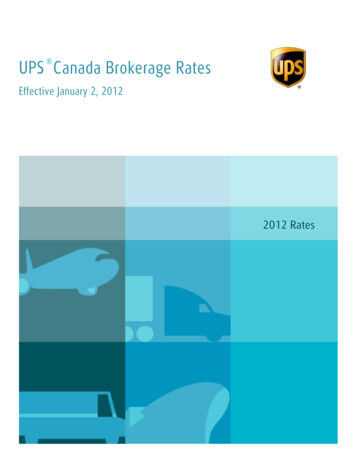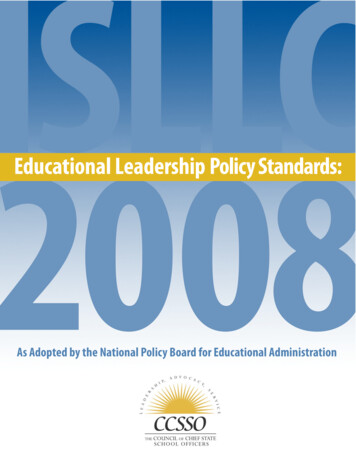
Transcription
ISLLC2008Educational Leadership Policy Standards:As Adopted by the National Policy Board for Educational Administration
Educational LeadershipPolicy Standards: ISLLC 2008As Adopted by the National Policy Boardfor Educational AdministrationCopyright 2008 by the Council of Chief State School Officers, Washington, DCContributions made by the National Policy Board for Educational AdministrationAll rights reserved.
Council of Chief State School OfficersThe Council of Chief State School Officers (CCSSO) is a nonpartisan, nationwide, nonprofit organization of public officials who head departments ofelementary and secondary education in the states, the District of Columbia,the Department of Defense Education Activity, and five U.S. extra-statejurisdictions. CCSSO provides leadership, advocacy, and technical assistanceon major educational issues. The Council seeks member consensus onmajor educational issues and expresses their views to civic and professionalorganizations, federal agencies, Congress, and the public.Rick Melmer (South Dakota), PresidentElizabeth Burmaster (Wisconsin), Past PresidentT. Kenneth James (Arkansas), President-ElectGene Wilhoit, Executive DirectorOne Massachusetts Avenue, NW, Suite 700Washington, DC 20001-1431Phone (202) 336-7000Fax (202) 408-8072www.ccsso.orgNational Policy Board for Educational AdministrationThe following organizations and councils are members of the NationalPolicy Board for Educational Administration (NPBEA): American Associationof Colleges for Teacher Education, American Association of SchoolAdministrators, Association for Supervision and Curriculum Development,Council of Chief State School Officers, National Association of ElementarySchool Principals, National Association of Secondary School Principals,National Council for Accreditation of Teacher Education, National Councilof Professors of Educational Administration, National School BoardsAssociation, and University Council for Educational Administration.For the past two years, the NPBEA Interstate School Leaders LicensureConsortium (ISLLC) Steering Committee has been revising the ISLLCStandards. This steering committee asked each NPBEA organization toobtain input from its respective constituencies regarding the revision of theISLLC Standards. The NPBEA/ISLLC Steering Committee also created anational Research Panel that identified the research base for updating theseISLLC Standards. This document presents the updated standards, explainsthe research behind the revisions, and provides other material explaininghow the policy standards can be used.The Wallace FoundationThe Wallace Foundation supported the development of EducationalLeadership Policy Standards: ISLLC 2008 as part of its long-term commitmentto develop and share knowledge, ideas, and insights aimed at increasingunderstanding of how education leadership can contribute to improvedstudent learning. Many of the resources cited in this publication and othermaterials on education leadership can be downloaded for free atwww.wallacefoundation.org.
Table of ContentsForeword 1I. Introduction 3II. Policy Standards: Building a Better Vision for Leadership 5III. Research Offers New Insight on Education Leadership 9IV. A Comprehensive Strategy to Improve Education Leadership 11V. Educational Leadership Policy Standards 14VI. Making the Standards Work 16Appendix 1: Comparing ISLLC 1996 and ISLLC 2008 18Appendix 2: ISLLC 2008 at a Glance 19Appendix 3: Glossary of Terms 20AcknowledgementsNPBEA Members 21NPBEA/ISLLC Steering Committee Members 22NPBEA Research Panel Members 23Bibliography 24To review the extensive collection of research that was studied during the development of the policystandards and additional research conducted subsequent to this work, please go to:www. ccsso.org/ISLLC2008Research
Dear Colleagues:We are very pleased to announce the publication of Educational Leadership Policy Standards:ISLLC 2008, as adopted by the National Policy Board for Educational Administration (NPBEA).We have been privileged over the past two years to co-chair NPBEA’s Steering Committee.Convened by NPBEA (the member organizations are listed on page 21) in response to requestsfrom our constituents for updated leadership standards, the Steering Committee developedand guided a process for updating the 1996 Interstate School Leaders Licensure Consortium(ISLLC) Standards for School Leaders. We relied heavily on professional groups and stakeholdersthroughout the process, and the new standards are the result of this national collaboration. Theyincorporate what has been learned about education leadership in the past decade and addressthe changing policy context of American education.These standards retain the structure or “footprint” of the six original ISLLC Standards, butthey are written for new purposes and audiences. Educational Leadership Policy Standards: ISLLC2008 reinforces the proposition in the original ISLLC Standards that leaders’ primary responsibility is to improve teaching and learning for all children. However, the updated standards areexplicitly policy-oriented because the 1996 ISLLC Standards for School Leaders have been sowidely used as a model for state education leadership policies.We are committed to gathering reactions to and learning from experience with these newpolicy standards in order to keep them vibrant in the ever-changing education policy arena.We encourage you to contact your respective organizational representatives with your feedbackon Educational Leadership Policy Standards: ISLLC 2008. These standards are intended to enhancethe field by stimulating dialogue about a new conception of education leadership that willimprove policies and practices nationwide.Sincerely,Richard A. FlanaryJoseph H. SimpsonCo-Chair, NPBEA Steering CommitteeCo-Chair, NPBEA Steering Committee
ForewordBy Gene WilhoitExecutive Director, CCSSOEducation leadership is more important thanresearch on education leadership conductedever. States recognize that schools and dis-over the past decade, while Part IV explainstricts will not meet demanding requirementshow policy standards form the foundationfor improving achievement without effectivefor a continuum of policies and activities thatleaders. This publication, Educationalguide education leaders throughout theirLeadership Policy Standards: ISLLC 2008,careers. Part V presents the new policyrepresents the latest set of high-level policystandards for education leadership. Itprovides guidance to state policymakers asthey work to improve education leadershippreparation, licensure, evaluation, andprofessional development.As adopted by the National Policy BoardThese standards reflect the newinformation and lessons learnedabout education leadership.standards, while Part VI describes specificactivities, such as leadership academies andfor Educational Administration (NPBEA),professional development, that can bethese standards reflect the wealth of newguided by ISLLC 2008.information and lessons learned aboutThis standards document builds on theeducation leadership over the past decade.Council of Chief State School Officers’This document, which introduces thetradition of leadership in this area. TheEducational Leadership Policy Standards:Interstate School Leaders Licensure ConsortiumISLLC 2008 (hereafter referred to as ISLLC(ISLLC) Standards for School Leaders (hereafter2008), shows the importance of policyreferred to as ISLLC 1996) were written bystandards to leadership-related activities.representatives from states and professionalPart I discusses the high-profile demandsassociations in a partnership with NPBEA inplaced on education leaders to raise student1994–95, supported by grants from theachievement and the role that policyPew Charitable Trusts and the Danforthstandards can play in helping them meetFoundation. The standards were publishedthese growing expectations. Part II describesby CCSSO in 1996.the differences between ISLLC 2008 and theRecognizing the importance of updatingoriginal leadership standards, reviews thethat work, The Wallace Foundation providedupdating process, and makes the case for thesupport to review the growing base ofdevelopment of the new policy standards.research on education leadership and toPart III describes some of the highlights fromdisseminate ISLLC 2008.EDUCATIONAL LEADERSHIP POLICY STANDARDS: ISLLC 20081
While it was clear that school leaders wereessential to the smooth and efficient opera-entirety or as a template for developing theirtion of schools, when the 1996 standardsown standards. With these guiding standardswere developed there was little research orin place, states have been much moreconsensus on the characteristics of goodsuccessful in addressing school leadershipschool leaders, the role principals play inand needs at each stage of an educationraising student achievement, and the bestleader’s career.policies and practices for expanding thenation’s pool of effective administrators.In developing the new standards, NPBEAThese much-anticipated updated policystandards would not have been possiblewithout the tireless dedication of severalconsulted with policy-oriented, practitioner-groups and individuals. For over ten years,based organizations, researchers, higherthey have dedicated themselves to improv-education officials, and leaders in the field.ing the leadership of our nation’s schools.NPBEA also worked with a panel of scholarsStates should review the new policy stan-and experts in education administration todards and use them to shape, develop, andidentify the research base for updatinghelp implement the policies and practicesISLLC 1996—research that previously didthat will give our nation’s children the leadersnot exist.they need and deserve to succeed in the 21stThese standards helped lay the foundationcentury. Most states have made importantnecessary for states to develop—and beprogress toward improving their schoolmore informed as they built and supportedleaders, but more work needs to be done,—various levels of the educator system, fromparticularly to support and train leaders at allpreparation and induction to professionalstages along the career continuum. Wedevelopment and performance evaluation.believe these policy standards will provideSince then, 43 states have used the 19962ISLLC Standards for School Leaders in theirEDUCATIONAL LEADERSHIP POLICY STANDARDS: ISLLC 2008the foundation for this work.
I.IntroductionOver the past decade, dramatic changes havefrom ‘whether’ leadership really matters or isput education leadership at the forefrontworth the investment, to ‘how’ to train, place,of education policy research and debate.and support high-quality leadership whereResearch has taught us that school leadersit’s needed the most: in the schools andare crucial to improving instruction anddistricts where failure remains at epidemicraising student achievement. At the policylevels,” wrote Wallace Foundation Presidentlevel, school performance measures haveM. Christine DeVita in A Bridge to Schoolbeen codified in state and federal law to holdReform. Unfortunately, the same report alsoschools increasingly accountable for raisingnoted that “states are only beginning to putstudent achievement among students fromall population subgroups. At the same time,schools are under pressure to produce highschool graduates who are better trainedand who can adapt to an ever-changingworkplace.These mounting demands are rewritingadministrators’ job descriptions every year,making them more complex than ever.ISLLC 2008 keeps the “footprint” of theoriginal ISLLC standards, but is writtenfor new purposes and audiences.together coherent systems that reliablyachieve the goal of placing an appropriate,well-trained principal in every school.”Fortunately, the last decade has producedToday, education leaders must not onlymore research than ever about educationmanage school finances, keep buses runningleadership and the role that school leaderson time, and make hiring decisions, but theycan and should play in raising studentmust also be instructional leaders, dataachievement. One of the clearest lessonsanalysts, community relations officers, andfrom this research is that the states that arechange agents. They have to be able tousing education leadership standards are onmobilize staff and employ all the tools in anthe right track. According to an extensiveexpanded toolbox.review of the research literature funded byClear and consistent standards can helpThe Wallace Foundation, goal- and vision-them do this. ISLLC 2008 will help state policy-setting, which are articulated in the stan-makers strengthen selection, preparation,dards, are areas in which education leaderslicensure, and professional development forcan have the most impact. Standards andeducation leaders—giving these leaders theother guidelines have been shown to betools they need to meet new demands.essential tools in developing effective“The national conversation has shiftedpre-service training programs for principals.EDUCATIONAL LEADERSHIP POLICY STANDARDS: ISLLC 20083
Therefore, incorporating clear and consistenteducator development. Standards are thestandards and expectations into a statewidefoundation and can inform all components ofeducation system can be a core predictor ofan aligned and cohesive system—prepara-strong school leadership.tion, licensing, induction, and professionalDrawing on this new knowledge allowsdevelopment. They can help states set expec-policymakers and educators to devote moretations for licensure, guide improvements intime and energy to strategies that have beenadministrator preparation programs atshown to work. ISLLC 2008 is meant to servecolleges and universities, and influence theprocess for screening and hiring leaders, evenat the level of local school boards. Just asimportantly, they can set parameters fordeveloping assessment instruments, practicestandards, and professional development tofacilitate performance growth towardexpert practice.Additionally, they can inform state policies, not just for those coming into the field,but for all leaders as they move through theircareers. These standards can help to furtherclarify expectations for professional development and the performance of veteranprincipals. Ultimately, the standards can helpstates create a seamless set of supportingpolicies and activities that span the careercontinuum of an education leader.This document presents the newlyas a foundational piece for policymakers asadopted NPBEA standards coupled with thethey assess current goals, regulations,growing research base available on educa-policies, and practices of education leaders.tion leadership and suggestions for howThese policy standards can be used bypolicymakers to think about their system of4EDUCATIONAL LEADERSHIP POLICY STANDARDS: ISLLC 2008standards can help serve as the foundation ofan entire system of educator development.
II.Policy Standards:Building a Better Vision for LeadershipISLLC 2008 is designed to serve as a broad set How does a district or school evaluateof national guidelines that states can usethe skills and dispositions of a candidateas a model for developing or updating theirto improve student performance?own standards. These standards provide How does one evaluate appropriatehigh-level guidance and insight about thecontinuing education programs ortraits, functions of work, and responsibilitiesmentoring of new principals?they will ask of their school and districtleaders. Using the policy standards as a How does one evaluate existing schoolleaders in meeting accountability goals?foundation, states can create a commonlanguage and bring consistency to educationResponding to the Fieldleadership policy at all levels so that thereIn the fast-changing education policy envi-are clear expectations.ronment, a set of standards is only as good asGene Wilhoit, the executive director of thethe input on which it is based. ISLLC 2008Council of Chief State School Officers,addresses changes in the field and respondsdescribes policy standards as the first stepto input from practitioners and policytoward creating comprehensive, locallyleaders. Among the concerns addressed istailored approaches for developing andretaining high-quality leaders. The ultimategoal of these standards, as with any set ofeducation standards, is to raise studentachievement. These standards contribute tothis effort by improving coordination amongpolicymakers, education leaders, andThese standards provide high-levelguidance and insight about thetraits, functions of work, andresponsibilities expected of schooland district leaders.organizations. They do this by beginning toanswer questions such as: the fact that the 1996 standards were tooHow do schools of education know whatrestrictive, as the very nature of listingeducation leaders need to know as itexamples of leadership indicators wasrelates to every child meeting academicunintentionally limiting and negated otherachievement standards?areas that could have been included in anHow can schools of education effectivelyexhaustive listing.convey that knowledge in a coherentfashion?The new standards also respond toconcerns that the 1996 standards “froze”leadership preparation programs.EDUCATIONAL LEADERSHIP POLICY STANDARDS: ISLLC 20085
ISLLC 2008 is intended to encourage morerecommendations regarding how the policyflexibility in how leadership preparationstandards in this publication can be used toprograms define and view leadership. Also,influence leadership practice and policy.by providing a representative sample ofOther points of comparison between ISLLCempirical research, the new standards1996 and ISLLC 2008 include:provide background material that was not contained in the 1996 standards.“broad standards” are similar, yet notThe most fundamental change, however,responds to the recognition that whenThe language and framework of the sixidentical. “Indicators” are not listed in the revisedimplementing the 1996 standards, somepolicy standards as they were in the 1996institutions used them differently, confusingversion. Policy standards are there to setpolicy standards with practice standardsoverall guidance and vision.and/or program standards. Consequently, Significantly, “functions” that define eachthis document states unequivocally, in its titlestandard have been added to replace theand elsewhere, that the standards here areknowledge, skills, and dispositions. It ispolicy standards and are designed to behere that research findings and feedbackdiscussed at the policymaking level to setfrom NPBEA and its members arepolicy and vision. NPBEA and other organiza-addressed.tions also are engaged in efforts to makeImproving Leadership StandardsEducational Leadership Policy Standards: ISLLC 2008 organizes the functions that helpdefine strong school leadership under six standards. These standards represent the broad,high-priority themes that education leaders must address in order to promote the successof every student. These six standards call for:1.Setting a widely shared vision for learning;2.Developing a school culture and instructional program conducive to student learningand staff professional growth;3.Ensuring effective management of the organization, operation, and resources for asafe, efficient, and effective learning environment;4.Collaborating with faculty and community members, responding to diversecommunity interests and needs, and mobilizing community resources;5.Acting with integrity, fairness, and in an ethical manner; and6.Understanding, responding to, and influencing the political, social, legal, andcultural contexts.6EDUCATIONAL LEADERSHIP POLICY STANDARDS: ISLLC 2008
While the titles of the standards and thisresearch identified and the interest in design-publication have been changed to makeing an interactive forum that can be regularlyclear that they are policy standards, theupdated by researchers and practitioners,“ISLLC” moniker remains. Because sothis information has been compiled into amany states have adopted the ISLLCdatabase now available online atstandards in one form or another, it iswww.ccsso.org/ISLLC2008Research.important to maintain this link.The initial research base, identified by theNPBEA research panel, contains empiricalDeveloping the Policy Standardsresearch reports as well as policy analyses,The new standards flow from a two-yearrevision process led by NPBEA. In revisingISLLC 1996, NPBEA consulted with its memberorganizations (see member list on page 21)and other policy-oriented, practitioner-basedorganizations, researchers, higher educationofficials, and leaders in the field. Additionally,NPBEA created a panel of scholars andexperts in education administration toidentify the research base for updating ISLLC1996—a majority of this research did notexist when those original standards werepublished.The NPBEA/ISLLC Steering Committee (seepage 22 for a complete list) carried out itswork in several phases. Each NPBEA memberorganization identified a strategy to obtainmembership input regarding the revision ofISLLC 1996. Once a draft of the revisedstandards was complete, the NPBEASteering Committee distributed copies toand gathered feedback from NPBEA memberorganizations, other professional groups, andleadership texts, and other resourcesthe research panel.considered to be “craft knowledge” andThe research panel was charged withidentifying a research base for updating ISLLC“sources of authority” in the field.Based on this extensive process of input1996 and for users of the updated standards.and feedback, the NPBEA Steering Commit-Because of the extensive nature of thetee revised drafts and finalized ISLLC 2008,EDUCATIONAL LEADERSHIP POLICY STANDARDS: ISLLC 20087
recommending the standards for adoptionby the NPBEA Executive Board.Starting in January 2008, NPBEA beganThe policy standards in this publicationwill form the foundation for further thought,research, dialogue, and debate on creatingupdating the Educational Leadershipstandards and guidelines that specificallyConstituent Council (ELCC) Programmeet the needs of practitioners. The intentStandards, which are used by the Nationalof NPBEA is to continue to refine the processCouncil for Accreditation of Teacher Educa-of policy standard revision so that thetion (NCATE) to review preparation programsstandards reflect changes in the knowledgein education leadership. The 2002 ELCCbase. ISLLC 2008 will serve as a catalyst forProgram Standards are based on the originalresearch efforts to study the implementationISLLC 1996. Updating them will contributeand effects of these policy standards andto a coherent vision and system of leadershipthe program and practice expectationsthat can guide state policies andaligned with or resulting from the policyleadership programs.standards.Setting the Stage for ISLLC 2008The following principles set the direction and priorities during the development ofthe new policy standards:1.Reflect the centrality of student learning;2.Acknowledge the changing role of the school leader;3.Recognize the collaborative nature of school leadership;4.Improve the quality of the profession;5.Inform performance-based systems of assessment and evaluation for school leaders;6.Demonstrate integration and coherence; and7.Advance access, opportunity, and empowerment for all members of the schoolcommunity.8EDUCATIONAL LEADERSHIP POLICY STANDARDS: ISLLC 2008
III.Research Offers New Insighton Education LeadershipAs noted in The Wallace Foundation 2007In How Leadership Influences Student Learning,report, A Bridge to School Reform, untilthey report that direct and indirect leader-recently there was little evidence about whatship effects account for about one-quarter ofeffective education leadership looks like andtotal school effects on student learning.the best ways to evaluate this leadership.Effective principals and school administra-In the past decade, a new research literaturetors set the organizational direction andhas filled this void. The research has drawnculture that influences how their teachersattention to the crucial connection betweenperform. According to How Leadershipschool leadership and student achievement.It gives state officials, education leaders, andthe institutions that train school leaders newresources to guide their standards, policies,and practices.ISLLC 2008 reflects the input of over 100Studies find leadership is secondonly to classroom instruction ininfluencing student outcomes.Influences Student Learning, the categoryresearch projects and studies, which helpedcalled “setting directions” is the area in whichguide the standards revision process and,education leaders have the greatest impact,ultimately, influence the standards presentedas the goals and sense of purpose theyin this document.provide strengthens the entire staff.Strong education leaders also attract,Effective Leaders PromoteBetter Teachingretain, and get the most out of talentedThis research consistently points out thatreviews, Leithwood and his colleaguesstates and districts are right to focus on stan-judged the research supporting thisdards for education leaders. School leadersconclusion “substantial” and that effectiveare critical to helping improve studenteducation leaders can enhance teachers’performance. Research now shows thatperformance by providing targeted support,leadership is second only to classroommodeling best practice, and offeringinstruction among school-related factors thatintellectual stimulation.influence student outcomes, according to anteachers. Drawing on previous researchResearch also finds that successful leader-extensive review of the research literatureship preparation programs—particularlyconducted in 2004 by Kenneth Leithwood,those that train principals who are willingKaren Seashore Louis, Stephen Anderson,and able to work in our most challengingand Kyla Wahlstrom.schools—are modeled and organized aroundEDUCATIONAL LEADERSHIP POLICY STANDARDS: ISLLC 20089
clear goals for systemwide values andMaking the Connections Among State, Districtlearning. A 2007 report by Linda Darling-and School Policies and Practices (2006), thereHammond and colleagues at Stanfordare three core system elements (namelyUniversity found that exemplary pre- andstandards, training, and conditions) thatin-service development programs fordetermine the quality of school leadership.principals have many common components,Adequate training and the right mix ofincluding “a comprehensive and coherentincentives and conditions are needed to helpcurriculum aligned to state and professionalfacilitate strong leadership. But the moststandards, in particular the NCATE/Interstateimportant element is “standards that spellSchool Leaders Licensure Consortium (ISLLC)out clear expectations about what leadersstandards, which emphasize instructionalneed to know and do to improve instructionleadership.”and learning and that form the basis forAccording to Leadership for Learning:10EDUCATIONAL LEADERSHIP POLICY STANDARDS: ISLLC 2008holding them accountable for results.”
IV.A Comprehensive Strategyto Improve Education LeadershipISLLC 2008 should be the starting point forTraining Programs with Establishedfuture thought, research, dialogue, andPerformance Expectationsdebate about standards for school leaders.Serving as a foundation, these policyCCSSO and NPBEA envision these standardsstandards are well poised to influence andas the foundation for a comprehensivedrive training and preparation programs.framework that addresses each stage of anISLLC 2008 plays out at the preparationeducation leader’s career. The new policyprogram level by establishing performancestandards build on ISLLC 1996 andexpectations and lends itself to aid in and cancomplement other standards and expecta-facilitate curriculum development, candidatetions related to education leadership.assessment, and accountability. CertainlyAs a set of policy standards, ISLLC 2008ISLLC 2008 is already informing the NCATEoffers high-level guidance to policymakersaccreditation process and the programand education leaders as they set goals andstandards that guide NCATE’s work. In 2002,design their own standards. Becausethe NPBEA-appointed Educational Leader-improving student achievement at the stateship Constituent Council released Standardslevel requires coordinated policies tofor Advanced Programs in Educational Leader-cultivate excellent leadership at the schoolship; they are now reviewing those standardsand district levels, policy standards establishso that they will be aligned with ISLLC 2008.common goals for policymakers andThe CCSSO State Consortium on Educationorganizations as they form policies regardingLeadership (SCEL) will release in the spring ofschool leadership and set statewide goals for2008 Performance Expectations and Indicatorsschool leadership development.for Education Leaders: A Companion Guide toThese policy standards were updated tothe Educational Leadership Policy Standards—provide a framework for policy creation,ISLLC 2008. Describing those expectationstraining program performance, life-longthrough dispositions, elements, andcareer development, and system support.indicators will help to operationalize theGiven their broad nature, they can influencepolicy standards at a more granular level.and drive many system supports andchanges which will ultimately lead toeffective instructional leadership thatLicensing and InductionIn turn, ISLLC 2008 can inform licensingpositively impacts student achievementand induction programs, which assess new(please refer to graphic on page 13).leader professional knowledge. This helps toensure that the new leaders in the system canEDUCATIONAL LEADERSHIP POLICY STANDARDS: ISLLC 200811
demonstrate adequate professional knowl-Performance-Based Principal Evaluation. Theseedge before moving into their position. Theseevaluations, developed collaboratively bypolicy standards are an anchor and will helpthe
Educational Leadership Policy Standards: ISLLC 2008 (hereafter referred to as ISLLC 2008), shows the importance of policy standards to leadership-related activities. Part I discusses the high-profile demands placed on education leaders to raise student achievement and the role that policy standards can play in helping them meet

